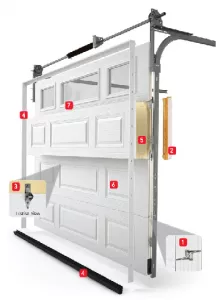
From a distance, many insulated garage doors seem similar, and when the R-values (or RSI) of two doors are equivalent, aren’t I getting the same bang for my buck? Definitely not! Take a closer look and if a door isn’t equipped with effective thermal breaks and top-performing weatherseals, you may be unnecessarily losing heat to the outdoors.
So if the time has come to buy a new garage door, here is what all homeowners should know when shopping around.
These specific features should be present if you want to get the biggest reduction in your heating and air conditioning bill:
Wood (yes wood!) end blocks
When manufacturing a quality garage door, section end blocks are used to keep the insulating material in place. An equally important purpose is to secure the hinges to the ends of the door. Then to complete and seal each section, weatherstripping and/or a glue joint is introduced to link the interior and exterior metal sheets.
It is common among North American garage door manufacturers to use a process of cutting steel sheeting about 26″ wide (66 cm) to the length needed for a door. To close the ends, they simply use steel end caps. Unfortunately, this can cause the plight of thermal bridging with the metal transferring the heat out of or into the garage.
Garaga has its own way of doing things! First, it uses a different injection and manufacturing method where each section is made individually. Wood end blocks, because wood does not transfer heat, are used to close the ends of each section prior to placing the insulation. This way, the outside temperature is not conducted to the interior and is hence called a thermal break. Now that is what you want!
The joints between door sections
We just talked about two exterior sheets of steel that cover the insulation, inside and out. One method used to attach the two sides together is by using a metal staple with or without glue. Again, this can cause the undesired transfer of heat.
Once again, Garaga has developed a thermal break, this time one that uses a triple‑contact PVC weatherseal to connect the two sheets. This keeps the exterior metal from touching the interior metal, thus no thermal bridge – the ideal situation.
Weatherstripping around the outside of the door
Here is another place where Garaga quality and experience work in your favor. Many garage door manufacturers use a lower grade of PVC weatherstripping. Just placing this material below freezing for a couple days causes it to harden so much that it loses all flexibility.
The PVC weatherstripping used by Garaga is top quality, double-lipped, and earns arctic grade status because it stays flexible even down to -15 °F (-25 °C).
Weatherstripping outside of the door
As with the weatherstripping around the door, one that turns rock hard at freezing temps is not good when you want a great seal between the bottom of the door and the threshold.
In this case, Garage uses a TPE (Thermal Plastic Elastomer)‑based weatherseal that remains flexible down to an incredible -52 °F (-62 °C)!
So don’t forget…
Energy efficiency for a garage door is made up of many factors, both in its components and its construction.
Yes, the R-value (or RSI) attributed to a specific door is one thing, but it isn’t the only thing. Take time to examine the door or ask questions as to how it is manufactured. We’ve just gone over many possible areas where energy can be lost – at the ends of sections, between sections and weatherstripping around the door and at its bottom.
So don’t focus solely on R-values. You know what else to look for now.
Contact us toll-free anytime at 815-692-6690. We are your most knowledgeable advisors and can explain the best choice for you based on your most specific needs. And if you’d like a quotation, we can send you one by email.
We would also enjoy meeting you face to face at our showroom. As well, you can try out our Design Centre to see what style suits you best. Another idea is to peruse our image gallery that’s full of appealing garage door examples.








Add new comment